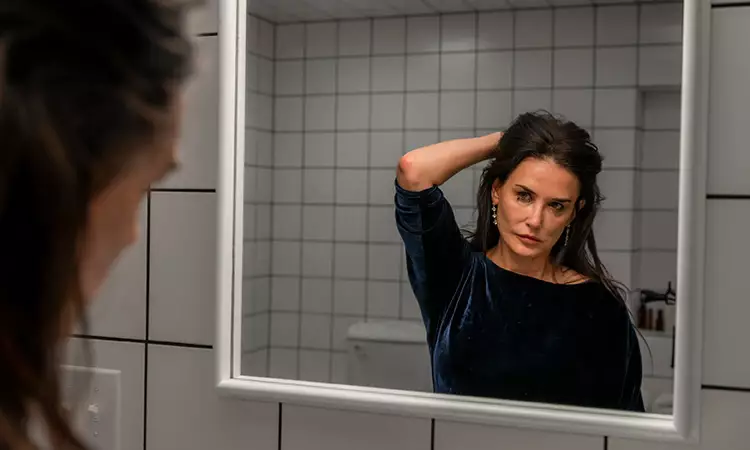In Angela Carter’s influential work, “The Sadeian Woman,” she poignantly asserts, through Leslie Fielder’s lens, that the romanticized ideals of women throughout history serve primarily as tools for their subjugation. This sentiment resonates acutely in Coralie Fargeat’s provocative body horror film, “The Substance,” which serves not only as entertainment but as a reflection on the corrosive nature of Hollywood beauty standards. The film offers a biting critique of the lengths to which women, particularly those in the public eye, will go to maintain their relevance and desirability in a patriarchal society that rewards youth and beauty while discarding anything that threatens that illusion.
At the center of this shocking narrative is Elisabeth Sparkle, portrayed with breathtaking intensity by Demi Moore. As an aging aerobics instructor, Elisabeth embodies the quintessential struggle against the clock, waging a frantic war against societal expectations of attractiveness. Her desperation becomes palpable when she faces the harsh reality of being replaced by the fresh-faced Sue, played by Margaret Qualley. This moment not only catalyzes Elisabeth’s psychological unraveling but also underscores the brutal competition women must navigate within a male-dominated industry. As viewers, we are invited to witness not only her physical transformation but also the dismantling of her sense of self-worth, a theme that reflects broader societal implications.
Fargeat’s stylistic choices, reminiscent of genre-defining filmmakers such as David Cronenberg and Gaspar Noé, amplify the film’s themes. The grotesque portrayal of beauty, combined with a surreal, almost psychedelic aesthetic marked by John Carpenter-style synth scores, enhances the narrative’s horror elements. These innovative techniques, including disorienting camera angles and exaggerated characterizations, serve to underline the jarring contrast between the manic pursuit of beauty and the inner turmoil it incites. Each frame pulses with an underlying rage, showcasing how societal pressures distort the very identities they seek to mold.
“The Substance” deftly critiques the toxic dynamics inherent in the entertainment industry, where men often dominate at the expense of women’s autonomy. Through Fargeat’s lens, the exploitation of female characters becomes painfully transparent. The men in the film are depicted as both unscrupulous and sycophantic, feeding off the insecurities of the women around them. This power imbalance is laid bare as Elisabeth’s psychosis spirals—a shocking visual metaphor for the psychological toll of systemic misogyny. The film’s grotesque, exaggerated elements serve as a mirror, reflecting the societal expectations that leave women vulnerable and objectified.
As “The Substance” reaches its fever pitch, one can’t help but ponder whether the critique of beauty standards and gender inequality depicted within its narratives will catalyze real-world change. Despite its horror and satirical tones, the film serves as a desperate plea for recognition of the systemic forces that rob women of their autonomy. It leaves viewers grappling with questions about progress—whether any genuine shifts have occurred in society’s treatment of women or if the cycle of exploitation continues unabated. Ultimately, Fargeat’s work is not merely a film; it is a powerful commentary on the relentless struggles women face against societal expectations, and it forces us to confront the ugly realities masking beneath the veneer of beauty.

